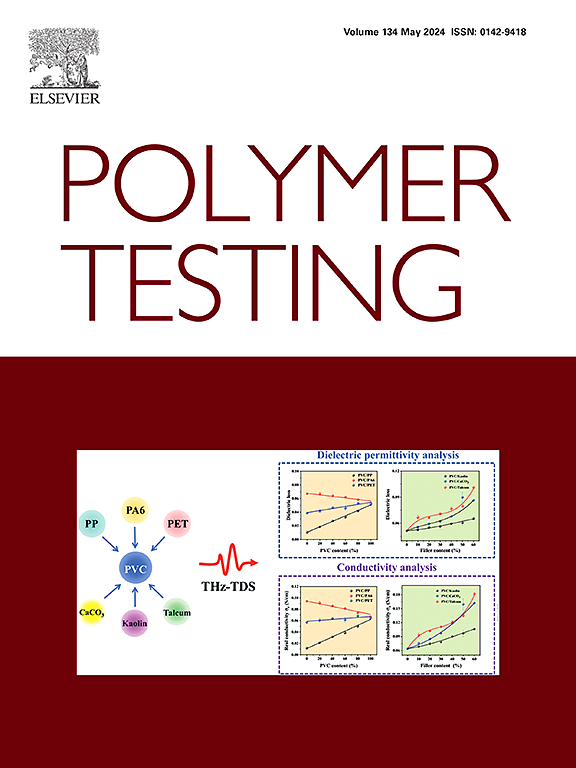Shape memory recovery in polylactic acid and thermoplastic polyurethane bi-material metamaterials fabricated by additive manufacturing under fatigue testing
IF 5
2区 材料科学
Q1 MATERIALS SCIENCE, CHARACTERIZATION & TESTING
引用次数: 0
Abstract
4D printing is defined as 3D printing plus the time. In this way, by applying a type of stimulus to the part fabricated by the 3D printing method and deformed, the sample returns to its original shape over time. This study advances the field of additive manufacturing by enhancing the design and functionality of shape memory polymers, enabling smarter, more adaptable materials for applications in aerospace. It can be mentioned as folding wings, solar sails, and actuator parts. In this research, the characteristics of the shape memory of the parts printed using fused deposition modeling (FDM) under fatigue loading were discussed. The printed parts comprised two types of polylactic acid polymer (PLA) and thermoplastic polyurethane (TPU). Three different percentages of the material composition were considered PLA, PLA/25TPU, and PLA/50TPU. Initially, rotary bending fatigue test was performed at a frequency of 100 Hz, but the samples delaminated. As a result, a vibration simulation was conducted using Abaqus software. The results showed that the natural frequency of the samples was very close to 100 Hz. To avoid resonance, the tests were conducted at a frequency of 20 Hz to obtain their lifetimes. Then, the shape memory recovery was implemented under fatigue (cyclic) loading by applying the time and temperature stimuli. A statistical sensitivity analysis was also done for the obtained results. Finally, the fracture surface of the specimens was evaluated by field-emission scanning electron microscopy (FE-SEM).
The results of the rotary bending fatigue test showed that the fatigue lifetime decreased with the increase in the TPU percentage. In addition, the results of shape memory properties illustrated that with the addition of 25 % of TPU, the rate of deformation increased by 40 %, on average. Moreover, it was concluded that the temperature had about 64 % more influence than the time on shape memory properties. In addition, fatigue (cyclic) loading was 137 % more effective than static (monotonic) loading. The results of the statistical analysis also demonstrated that the shape memory properties increased with the enhancement of the TPU percentage. The images of the fracture surface showed the separation of layers and cavities, which were the factors of failures. Beach marks indicating the failure under fatigue loadings were also seen.
增材制造制备的聚乳酸和热塑性聚氨酯双材料的形状记忆恢复疲劳试验
4D打印被定义为3D打印加上时间。通过这种方式,通过对3D打印方法制造的部件施加一种刺激并使其变形,样品随着时间的推移恢复其原始形状。这项研究通过增强形状记忆聚合物的设计和功能,推动了增材制造领域的发展,为航空航天应用提供了更智能、适应性更强的材料。它可以被称为折叠翼,太阳帆和执行器部件。研究了疲劳载荷下熔融沉积(FDM)打印零件的形状记忆特性。打印的部件由两种类型的聚乳酸聚合物(PLA)和热塑性聚氨酯(TPU)组成。三种不同百分比的材料组成被认为是PLA, PLA/25TPU和PLA/50TPU。最初,在100 Hz的频率下进行旋转弯曲疲劳试验,但样品分层。利用Abaqus软件进行了振动仿真。结果表明,样品的固有频率非常接近100hz。为了避免共振,测试在20赫兹的频率下进行,以获得它们的寿命。然后,通过施加时间和温度刺激,在疲劳(循环)载荷下实现形状记忆的恢复。并对所得结果进行了统计敏感性分析。最后,利用场发射扫描电镜(FE-SEM)对试样的断口形貌进行了分析。旋转弯曲疲劳试验结果表明,疲劳寿命随TPU含量的增加而降低。此外,形状记忆性能的结果表明,当TPU添加量为25%时,变形率平均提高了40%。结果表明,温度对形状记忆性能的影响比时间大64%。此外,疲劳(循环)加载比静态(单调)加载有效137%。统计分析结果还表明,形状记忆性能随TPU含量的增加而提高。断裂面图像显示出层状和空腔的分离,这是破坏的因素。海滩标志表明疲劳载荷下的破坏也被看到。
本文章由计算机程序翻译,如有差异,请以英文原文为准。
求助全文
约1分钟内获得全文
求助全文
来源期刊

Polymer Testing
工程技术-材料科学:表征与测试
CiteScore
10.70
自引率
5.90%
发文量
328
审稿时长
44 days
期刊介绍:
Polymer Testing focuses on the testing, analysis and characterization of polymer materials, including both synthetic and natural or biobased polymers. Novel testing methods and the testing of novel polymeric materials in bulk, solution and dispersion is covered. In addition, we welcome the submission of the testing of polymeric materials for a wide range of applications and industrial products as well as nanoscale characterization.
The scope includes but is not limited to the following main topics:
Novel testing methods and Chemical analysis
• mechanical, thermal, electrical, chemical, imaging, spectroscopy, scattering and rheology
Physical properties and behaviour of novel polymer systems
• nanoscale properties, morphology, transport properties
Degradation and recycling of polymeric materials when combined with novel testing or characterization methods
• degradation, biodegradation, ageing and fire retardancy
Modelling and Simulation work will be only considered when it is linked to new or previously published experimental results.
 求助内容:
求助内容: 应助结果提醒方式:
应助结果提醒方式:


